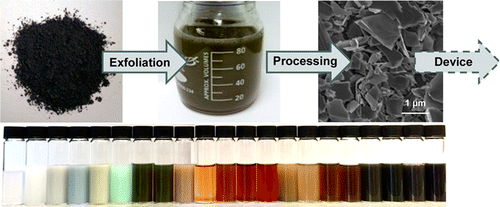当前位置:
X-MOL 学术
›
Chem. Mater.
›
论文详情
Our official English website, www.x-mol.net, welcomes your
feedback! (Note: you will need to create a separate account there.)
Guidelines for Exfoliation, Characterization and Processing of Layered Materials Produced by Liquid Exfoliation
Chemistry of Materials ( IF 7.2 ) Pub Date : 2016-11-02 00:00:00 , DOI: 10.1021/acs.chemmater.6b03335 Claudia Backes 1, 2 , Thomas M. Higgins 1, 2 , Adam Kelly 1 , Conor Boland 1 , Andrew Harvey 1 , Damien Hanlon 1 , Jonathan N. Coleman 1
Chemistry of Materials ( IF 7.2 ) Pub Date : 2016-11-02 00:00:00 , DOI: 10.1021/acs.chemmater.6b03335 Claudia Backes 1, 2 , Thomas M. Higgins 1, 2 , Adam Kelly 1 , Conor Boland 1 , Andrew Harvey 1 , Damien Hanlon 1 , Jonathan N. Coleman 1
Affiliation

|
Liquid phase exfoliation has become an important method for the production of large quantities of two-dimensional (2D) nanosheets. This method is versatile, having been used to produce dozens of different 2D materials in a range of stabilizing liquids. The resultant liquid-suspended nanosheets have been characterized in great detail and have been processed into a number of structures for a wide range of applications. This has led to a growing number of researchers adopting this method. As a result, best practice in terms of experimental procedure has evolved rapidly over recent years. As experimental complexity has increased, it has become more and more difficult to discuss the rational behind a chosen experimental procedure in full detail using standard “Methods” sections due to the frequent use of procedures developed in related prior reports. This can make it difficult to reproduce complex procedures and acts as a barrier to new researchers entering the field. To address this shortcoming, here we describe in detail the experimental methods and best practice used in our group when producing liquid exfoliated nanosheets.
中文翻译:

液体剥落产生的分层材料的剥落,表征和加工指南
液相剥离已成为生产大量二维(2D)纳米片的重要方法。该方法用途广泛,已用于在多种稳定液中生产数十种不同的2D材料。所得的液体悬浮的纳米片已被详细表征,并已被加工成多种结构,可用于广泛的应用。这导致越来越多的研究人员采用这种方法。结果,近年来,关于实验程序的最佳实践发展迅速。随着实验复杂性的增加,由于频繁使用相关先前报告中开发的程序,使用标准的“方法”部分来详细讨论所选实验程序背后的原理变得越来越困难。这可能会使复制复杂的程序变得困难,并成为新研究人员进入该领域的障碍。为了解决这个缺点,在这里我们详细描述了在生产液体剥落纳米片时我们小组中使用的实验方法和最佳实践。
更新日期:2016-11-02
中文翻译:

液体剥落产生的分层材料的剥落,表征和加工指南
液相剥离已成为生产大量二维(2D)纳米片的重要方法。该方法用途广泛,已用于在多种稳定液中生产数十种不同的2D材料。所得的液体悬浮的纳米片已被详细表征,并已被加工成多种结构,可用于广泛的应用。这导致越来越多的研究人员采用这种方法。结果,近年来,关于实验程序的最佳实践发展迅速。随着实验复杂性的增加,由于频繁使用相关先前报告中开发的程序,使用标准的“方法”部分来详细讨论所选实验程序背后的原理变得越来越困难。这可能会使复制复杂的程序变得困难,并成为新研究人员进入该领域的障碍。为了解决这个缺点,在这里我们详细描述了在生产液体剥落纳米片时我们小组中使用的实验方法和最佳实践。





















































 京公网安备 11010802027423号
京公网安备 11010802027423号